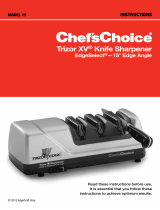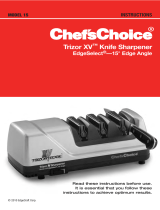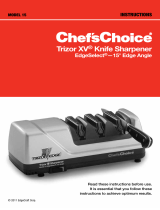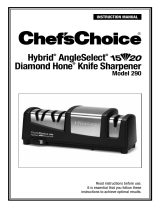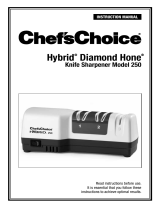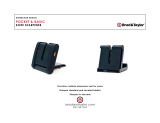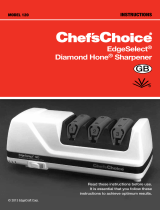
4
UNDERSTANDING THE VERSATILE
MODEL 120 EDGESELECT
®
SHARPENER
The unique Chef'sChoice
®
EdgeSelect
®
Diamond Hone
®
Sharpener is designed so that you
may sharpen each knife according to your intended use, such as gourmet food preparation,
butchering, dressing of game or filleting of fish. You can sharpen knives with either straight or
serrated edges. This three (3) stage sharpener has two precision conical sharpening/honing
stages with fine 100% diamond abrasives and one polishing/stropping stage using proprietary
flexible abrasive disks. These stages can be used in different sequences to give you either an
astonishingly sharp, smooth faceted edge for effortless cutting and presentations or one with a
selected amount of residual "bite" along the facets. The edge is ultra sharp and non-serrated.
This residual "bite" is created by precisely polished micro flutes that are formed on the facet
surface by the ultra honing action of the stropping disks in Stage 3. You will find that these sharp
flutes on each side of the ultra sharp and non-serrated cutting edge aid substantially in those
difficult cutting chores experienced with fibrous foods, meats, stalky vegetables, dressing of
game or household chores such as cutting cardboard, leather, carpet, etc.
The sharpening and honing/polishing actions are controlled by using precision angle guides for
the blade and precisely matched conically shaped abrasive disks. The sharpening angles are
several degrees larger in each successive stage.
Fine diamond-coated conical disks in Stage 1 create microgrooves along the facets on each
side of the edge, establishing the first angled bevel of the Trizor
®
edge.
In Stage 2, finer microgrooves are created across the facets immediately adjacent to the edge
by still finer diamonds as they establish a well defined second bevel on the facets that is a few
degrees larger than the bevel developed in Stage 1.
In Stage 3, ultra fine abrasive disks are set at a third and slightly larger angle. They polish and
strop the facets immediately adjacent to the edge creating a third micro bevel and establish a
microscopically thin, straight and super polished edge of astonishing sharpness. The stropping
action simultaneously polishes and sharpens the boundaries of those microgrooves created by
the diamond abrasives in Stages 1 and 2 adjacent to the edge until they become sharp micro
flutes that will assist the cutting action of "difficult to cut" materials.
This unique three stage design gives you an edge of remarkable sharpness and, because of the
triple angle bevel it creates on each facet, you will note knives stay sharp much longer.
The following sections describe the general procedures for optimal sharpening in each stage
and then suggest how you can optimize the edge for your intended uses.
Unless you do a lot of heavy duty cutting you will need to use Stage 1 only infrequently. One of
the important advantages of using the EdgeSelect
®
Model 120 is that you can strop and polish
your knives to razor sharp edges as often as needed and yet experience little knife wear
compared to older sharpening methods. Resharpening can usually be done in Stage 3. Use
Stage 2 less often for resharpening and use Stage 1 only for the heaviest duty applications.
(See Resharpening Section).












